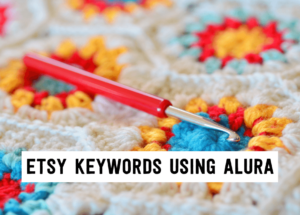
How to find the best Etsy keywords in 3 simple steps using Alura
If you want to be found in search results on Etsy, you need to optimize your product listing for SEO. And if you want to
join
join
Many of the makers I work with sell on Etsy – and Etsy is a wonderful place to set up and grow your handmade business – but at a certain point in your business growth you might start wondering:
“How can I scale my handmade business. . .
… and is it possible to do it all on Etsy?”
Now of course you can grow your business on Etsy, but I can tell you without a shadow of a doubt that opening your own website gives your business growth and scaling opportunities that you simply can’t get on Etsy.
There are 4 main things you need to focus on when you want to scale your handmade business, and today we’ll look at what these are and how having your own website vs. focusing on Etsy might impact your business as you scale.
So, ready? Let’s dive in.
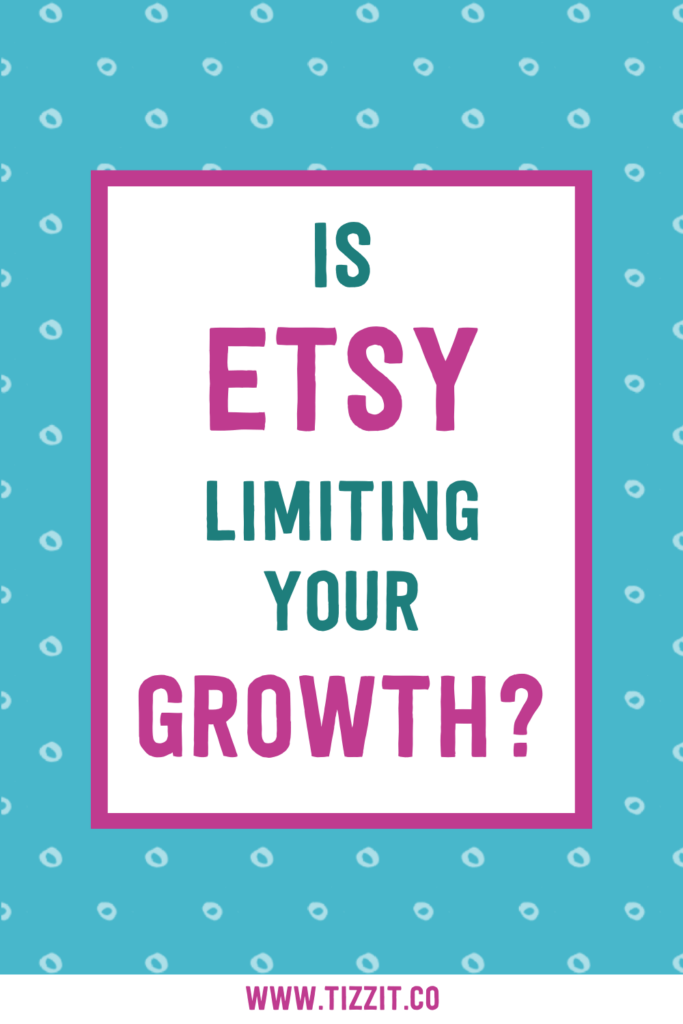
Now – this is NOT an anti-Etsy article. I’m not anti-Etsy, I actually LOVE Etsy and help people sell on Etsy every day.
This isn’t what this article is about.
What I’m talking about today is how Etsy can make scaling your handmade business more difficult and unreliable vs. when you have a shop your own website.
There are a lot of limitations when you sell on Etsy, and there are definitely some cases where it’s my job to recommend to people that it’s time they grow their own wings and start their own website so that they can really grow and scale their business.
So I’m not saying you can’t make good money on Etsy – I know makers that are making 6 figures and multiple 6-figures on Etsy. What I am saying, though, is that
or
Here’s why.

FREE WORKBOOKS, CHEAT SHEETS, AND RESOURCES TO HELP YOU START, GROW AND PROFIT FROM YOUR HANDMADE BUSINESS.
The goals of scaling a handmade business are really very simple (notice how I didn’t say “easy,” but it is simple!):
Each of these statements can be measured by a key metric:
Let’s take a look at how Etsy can help you (or limit you) in growing those 4 metrics and compare that to what you could do with your own website instead.
Quick note before we dive in:
I will give you a good solid overview of each one in this article – but I plan to make future articles about each of these so I can go more in-depth on each point, so be sure to sign up for notifications of new blogs and videos once you’re done reading this article!
This is really about increasing your conversion rate.
Basically, when you have your own website you’re in control of everything on that website. So you can design it in the exact way that you need in order to get people who visit your site to take the action that you want them to take.
You can design the exact layout that you want and the exact experience that you need people to have to encourage them to convert more easily.
How is that different from Etsy?
Well, Etsy’s conversion optimization is made so that people shopping on Etsy buy something from ANY Etsy store — they design the customer experience at the marketplace level, not at the shop level.
For example, at the bottom of your product listing page, there are heaps of links to other listings that people might be interested in that are not yours, that are not in your store. And that’s because the goal of Etsy is to make sure that people are buying something when they are on the Etsy website, whether it’s from your store or not.
And that’s okay – I’m not criticizing that fact – that’s their business and it makes sense that they don’t care which store gets the sale because, from a business perspective, Etsy needs to focus on their own end goal. Etsy is going to encourage customers to go and visit other shops and other listings if they think it’s more likely someone will purchase this way.
But . . . imagine what you could do instead with your own website! Once you bring in traffic, customers go on your product pages, your homepage, your category pages — and you get to decide the products that are recommended at each step along the way.
You get to test different layouts, you get to decide what goes where and what you’re communicating – every step of the way.
You can optimize your conversion rate on Etsy (to a certain degree) of course – I spend a lot of time teaching this to the Etsy sellers I work with. Your photos, descriptions, how you present your store – it all counts.
But at the end of the day, you’re still playing within the limitations of how Etsy sets things up.
On your own website … it’s a whole different ball game!
For #2, we are talking about increasing your Average Order Value, so getting each customer to spend more with each order. They are many different strategies to achieve this but it basically comes down to offering:
I have an article all about strategies to increase your Average Order Value that you will definitely want to read after this one!
Now of course on Etsy you’re going to find ways to try and do these things, but you won’t have the ability to implement it as properly as you could on your own website.
You can still bundle products, you can still send people from a listing to another listing via a link in the description and get them to purchase different products for example — but it’s going to be much more of a clunky experience from the visitor perspective vs. how smoothly you can make that happen on your own website.
On Etsy you do these things and HOPE that people do them. On your own website, you can ensure they see and do and click on the right buttons to purchase more from you.
It might seem like nothing but it’s EVERYTHING. Bumping up your average order value is incredibly, incredibly important if you want to scale your business, and Etsy really does make this difficult.
I could find a dozen more, but let’s look at just ONE example.
Say you want to offer $10 off for orders over $120.
On Etsy, you can set this up under your Shop Manager under Sales and Discounts. It will let you create a custom promo code that your shoppers can use when they spend over that specified amount to get the discount.
Sounds good on paper but the reality is not many people use them or find those enticing enough to get them to buy right here right now.
It’s really not a very smooth experience. Your customers need to…
You can share the coupon in your shop announcement, in your listing description and photos… but how many people will really see it, remember it, and use it once they go to checkout?
On your website, you can set up the same offer but the experience is much smoother.
For example “Add this shampoo to your order and qualify for $10 off!” or “you’re only $16 away from getting $10 off, why not add a bath mitt to your order to qualify?”
Think of how effective those kinds of things would be to bump up your Average Order Value!
It’s personalized, it’s easy, and it’s automated every step of the way, and it’s also targeted to each buyer’s experience.
I know it might not seem like a lot, but keep in mind this is just ONE example. I could give you 20 more.
And if every little improvement you make to the customer experience in your store bumps up your Average Order Value by even just 1% – at the end of the month you’ve got 20% more revenue from doing things in a way you can’t on Etsy.
The bottom line is, there are things you simply can’t do with Etsy, plus there are also many more things (like the example we just went over) that you in theory can do, but can only truly make them work at scale when you have more control over how things are done.
Next, I want to talk about customer lifetime value and email marketing.
When you have an established business, email marketing should represent at least 25% of your revenue. At LEAST.
It is a serious driver of revenue and something that is really worth focusing on.
You should not think of it as an optional thing, it’s not like social media where you get to decide what you want to do and what you don’t want to do.
Email marketing is a must-have. And I rarely say anything is a must-have but I really mean it with email marketing.
Email marketing is the marketing engine inside of your business, and your goal is to get potential customers on your email marketing list. If you’re new to email marketing you will want to read my article about email marketing basics to learn more.
Of course you’re also going to get sales from people who come directly to your website before they even get to your email list. But the majority of your sales are going to come from getting people to sign up for your email list, and then selling to them via your email marketing system after that. Not just once, but repeatedly.
That’s what helps you build up a higher Customer Lifetime Value.
If someone purchases from you once at $60, that customer lifetime value is $60.
But what if you could get your customers to on average purchase 5 times over 2 years? Then your lifetime customer value is not $60 but $300!
So now, each customer coming through your door will bring in $300 in revenue.
And one of the best ways to increase your customer lifetime value is with targeted, timely email campaigns.
Now – email marketing is possible with Etsy, but here again – it’s much more limited.
That’s because
and
There are definitely ways to encourage people on Etsy to sign up for your email list, but because of the 2 reasons I just shared, it can be pretty cumbersome:
You can – and should – create graphics that say sign up for our newsletter, have it on your banner, in your product descriptions, etc, but you can’t put a hyperlink in them . . . so people can’t actually CLICK those links.
If they want to sign up for your newsletter, they have to open a new tab, MANUALLY type in the URL to your email sign-up page, find the signup box, and enter their email.
That’s just a lot of things to do … and I promise you if it’s not easy people won’t do it or at least a much much much smaller percentage of people will do it.
Getting people to sign up for your email list from your own website is much easier because here again… the experience is much smoother. You’re in control, they can sign in directly on your website, and they don’t need to go anywhere.
Once you have their email, you can also integrate your website platform with your email service provider in ways you can’t even dream of doing with Etsy to ensure you email them the right offers at the right time and get them to purchase again and again.
By having your own website you can not only boost your Average Order Value and make sales more often, but with email marketing you’re going make sure that you get several purchases across the months and the years from the same customers — by knowing exactly what they’ve browsed, what they added to cart but didn’t quite buy, when their birthday is . . . just think of the all the options you have now! You can send them offers related to what you know about them, their browsing history and interests . . . the possibilities just exponentially increase.
Here’s an article just about ALL the things you can do with email marketing when you have your own website. You can do all sorts of things that are going to really leverage the lifetime cycle of the customer and bring more sales from the same customers.
The couple of emails Etsy sends for cart abandonment or when someone favorites an item don’t get anywhere close to what you can do when you OWN your customer’s and potential customer’s data.
This is the key difference here: Etsy wants you to make sales, but they don’t want you to own that data because it doesn’t make business sense for them. They want to hold the emails and control what they send to encourage people to buy again on their platform (not on your website) and not necessarily always from your store.
In short, it’s not only easier to grow your email list outside of Etsy, but once you have your list, it’s also much easier to convert those people into customers time and time again.
You all know that the more traffic you get (so the more visits to your store), the better.
And you probably also know that there are 2 ways to get traffic for your Etsy business: organic (free), and paid (ads).
On Etsy, SEO is the most powerful way to bring traffic to your store. They have built-in buyers and with the right SEO, you can get your products in front of them.
It’s true that Etsy can help you get traffic with their SEO . . . BUT it is also a very crowded place, so you can’t rely on SEO alone to bring traffic to your store.
And even if you are, and are really successful using SEO, you’ll likely get to a point where you hit a ceiling for what you can get from Etsy SEO and you will want to scale your traffic further – which means you will eventually need to bring traffic from the “outside.”
You can run paid ads that bring traffic to your Etsy shop, but the problem is that when you do, you are at risk of losing that traffic when they land on Etsy because they can easily click away to any other Etsy store once you’ve done the hard work of bringing them to yours.
Plus – you’re very, VERY limited compared to the amount of customization and targeting and retargeting options that you can do on platforms like Facebook, Instagram, Pinterest, and YouTube . . . even Tiktok is becoming more of an option as they get more users and more data about those users.
It’s still a good thing to do on Etsy – don’t get me wrong – it allows you to take your business to the next level and is something you should seriously consider.
And when I say seriously consider – I mean that you should do it! If you have the money to invest in your business, why wouldn’t you pay to get people to come to your store, purchase, and become lifelong customers?
It’s like having a tap of customers you can turn on.
Of course, you might not have a budget to test ads initially when you haven’t made sales. But when you start selling and getting a bit of traction, your profit margins should be at a level that you have money to reinvest into your business. That’s one of the many reasons you need healthy profit margins and it’s a key component of a good pricing strategy.
But paid traffic when you have your own website is a whole different ball game.
Now every ad you pay for is customized and targets or retargets the exact customers who will want to buy your products, and when those people click on your ad they will be taken to YOUR website and only see YOUR products.
They will be on product pages that you have optimized for not only that product, but suggesting other products or bundles they might like.
And once they purchase, you will have access to all sorts of data about who they are, what they clicked on, and what they purchased, that you can use to make the next ads you run even more targeted to make that customer want to buy again!
Now – I won’t dive into the details of how you can customize and target your ads on platforms like Facebook and Instagram in this article because I will be creating an article all about how to do that effectively in the future, but I want to mention it as it is a primary reason having your own website allows you to grow and scale your business in ways you can’t do on Etsy.
You just can’t compare the options that you have available for paid traffic when you have your own website vs. when you sell on Etsy: the tracking that you have access to, the analytics that show you exactly how much you’re making from each campaign, the data that you can tap into, it really is night and day.
As I mentioned I will be doing an article for each of the 4 points we covered today in the future so we can dive into more detail for each of them and really look at the strategies you can implement in your handmade business to increase those 4 key metrics we talked about today.
So be sure to sign up for notifications of new blogs and videos… and until next time, aurevoir!
you might also like…
related articles

If you want to be found in search results on Etsy, you need to optimize your product listing for SEO. And if you want to
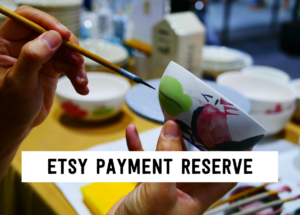
There has been a lot of talk in the Etsy community — and I mean A LOT of talk — about Etsy’s payment account reserve
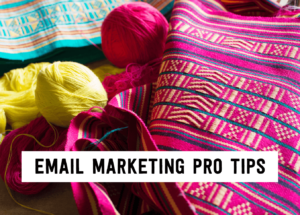
Anyone who knows me knows that I am a HUGE advocate for using email marketing to grow and scale your handmade business. But you may
disclaimer
subscribe to youtube
THE LAUNCHPAD
get in touch
We acknowledge and give thanks to the Budawang and Yuin people, the Traditional Owners of the land we work and live on. We pay our respects to all Aboriginal and Torres Strait Islander Peoples and elders past, present and emerging.
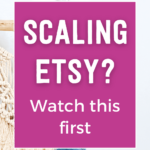
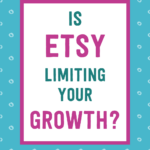

Get Instant Access to
The FULL Resource library